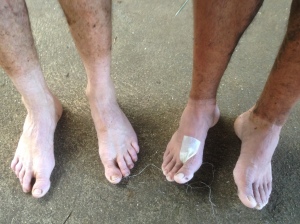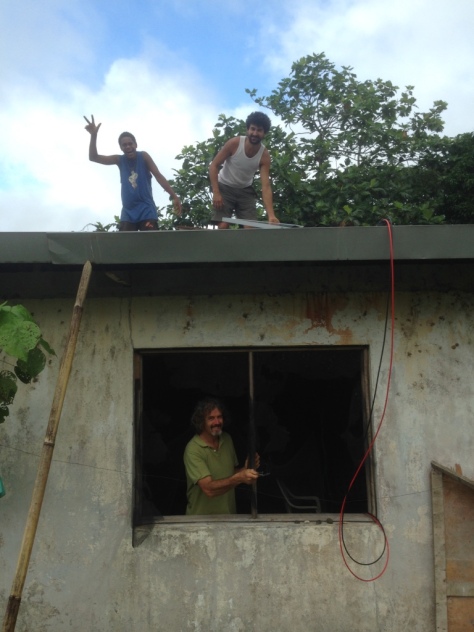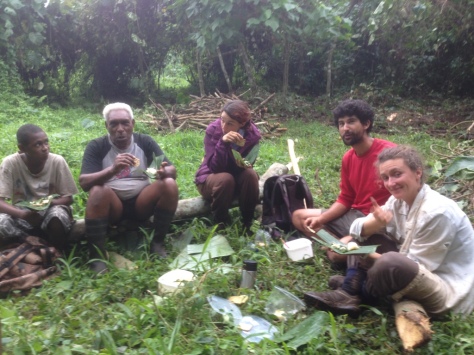


|
Commenced:
|
01/06/2015 |
|---|---|
|
Submitted:
|
07/07/2015 |
|
Last updated:
|
04/11/2015 |
|
Location:
|
Lambue, Belaru, Espiritu Santo, Luganville, Sanma province, VU |
|
Website:
|
www.permacultureluganville.org |
|
Climate zone:
|
Wet Tropical |
(projects i'm involved in)
Back to Permaculture Research Institute Luganville, Vanuatu
Project: Permaculture Research Institute Luganville, Vanuatu
Posted by Zaia Kendall almost 10 years ago
Hello everyone !
Here is the crew giving you some news from the bush !
As we had planned, we moved to Belaru into ‘José’s house’ on Monday the 6th of july .
After a busy early morning cleaning our pretty house and shopping in town, we went to the agricultural college near Luganville. There we were introduced by Tom to Joe Timothy, the Chief Executive Officer who was really happy to meet keen volunteers ready to start the project on site. Joe introduced us to Norah Rihai, the training manager, who was even more enthusiastic as she knows about permaculture from a previous training in Australia and is really keen to learn more about it! We talked about eventually organising internship training for Ni-Van students on the PRI Luganville site . We also spent a bit of time in the internal library with Etienne, a french speaker who lend us a great notebook on the Bislama language.
We finally caught up with Agnes and Ray to organise our move to Belaru at 3pm in between heavy showers!
I have to tell you that since we arrived two weeks ago we only had 3 days of sun!!! It looks like we are being given a wet season right in the middle of the dry season !

Anyway, up we went with all our packages, tools, kitchen gear and food for the first week, and we only filled up two vehicles !
After a bit of socialising with our new neighbours Frank, Ginette and Linden we hurried up to organise our room with bedding and mosquito nets. We ended up cooking in the night on a fire place in an old shipping container with a head torch. Delicious smoke flavoured kumara with our last piece of meat for a little while as we don’t have a fridge anymore.
We had a late morning after a long night on a concrete floor with snoring, bull snorting and pig squealing in the bush…. Just what we needed to get into the local bush ambiance !
After a Ni-Van brekkie made from boiled plantain bananas and a pawpaw, we set up a kitchen on an empty rusty bench, organised an ants proof food storage system, packed a take away lunch and installed the solar system. Dani climbed on the roof with Linden to point the solar panel to the North, we plugged in batteries and power board only to discover that a fuse was missing and we couldn’t use the inverter yet!

We started our 2km walk to the land quite late but reached it in 30 minutes. We spent this first day surveying, trying to identify boundaries to make a 10 hectare site out of this thick bush.
The surveying went well since the land is orientated on the cardinal points and we already have two fences on the West and South side . Helped by the GPS we cut a length of 480m along these fences on the South side since we found an edge point at 208m on the West side. Some clearing had been done a few years ago by the Packete family to start a new coconut plantation, we also found some taro, pineapples and two bananas trees on the edge corner as is usually done here in Vanuatu. The land slopes down from West to East on the first third, then slopes from South to North, the lower point is roughly at the middle of the North side at an average altitude of 159m. The higher point is the South West corner at an average of 175m, North West corner is 160m, the North East corner 163m and South East corner 164m. We then spent the afternoon clearing an opening track to mark the East side boundary and find the North East point.
We finally headed back home after harvesting cassava for dinner on Ray’s land next to ours, and we arrived home exhausted after the 2km damp walk. We were nicely welcomed by Agnes who prepared some tea in a brand new kettle bought especially for us !
She also put some beautiful curtains in the windows and a nice vinyl floor covering on the floor to insulate us from the concrete. Elton, her dad, who arrived with her to spend the next two weeks with us to build the bamboo huts on the land site, put in new doors and created a new room for himself. He also installed mosquito nets on every window!
Now settled as kings we inaugurated our bucket showers with delight and had yam patties made by Ginette and Tom. Home sweet home !!!!!!!
We found the ideal village site on the next day, 8th of July. Maybe it helped to have yummy plantain bananas patties for brekky and that the sun was shining… We reached the site in 25 minutes and started a grid pattern surveying the West side from south to north and coming back every 50m. We stopped our search when all of us agreed on the edge of the West side forest and a large grassy clearing. There we found a perfectly orientated hedge facing East, and we will situate the house on an angle so the South easterly wind hits the house diagonally. We decided to place the house under cover in the fresh shadow of the forest against big trees with flat draped base.
This site was voted for unanimously for a few reasons: its proximity to the South West corner of the land where the access track enters the block, the edge effect against the zone 5 forest which is not too thick and where the air can flow from and through, the proximity of an open garden zone, the gentle slope on the edge of the forest and the diversity of environment around the open clearing: a gully, old bulldozer tracks, high old forest pockets, one huge tree on the North side of the clearing. We just needed to ask Elton what he thinks about our location from his niVan point of view.
We finished surveying the land resumed following our grid pattern . The land is a succession of forest pockets, clearings and thick vines . We found some bamboo, hardwood palms and different kinds of timber, a few pig holes and empty coconut shells that we understood later were the remains of chicken traps.
On the 9th Elton came with us to the land. He did a little ‘kustom’ ceremony in the morning before we left. He offered Tom a shell necklace and they became ‘Brothers’, Meriem and I (Anne) his daughters and Dani his son in law . Arriving on the site Elton, now ‘Papa’, showed us a Nangalat tree, with stinging, burning leaves! We then understood where our burning skin came from! He validated the place for the house but advised us to bring it further East in the clearing as the natan gura roofing needs sun to dry. We debated a bit whether to keep the house in the shade and finally decided to bring it out a bit from the edge. An other main concern was a huge milkwood tree just next to the house location and as obvious as it was, we didn’t see that, quite risky in a cyclone sensitive area ! We will probably have to chop down this huge fellow.
After marking the house borders with pegs and strings without any measuring tape or square, we headed up for a bush tour to check out the timber trees available. Redwood is the stronger wood to use for posts, but we didn’t find any… as plan B we looked for palms but found only a few. We finally visited Ray’s land on the other side of the coconut plantation to check out the place where the natan gura grows, and had the great surprise of finding a lot of seedlings sprouting every where in between a lot of fruiting cacao trees, an amazing sample of biodiversity.
On the Friday 10th we had to change the chain on the chainsaw. Everyone started to be a bit tired and sick especially Dani who has a tummy problem, but he still found the energy to be a clown and dropped 3 very sharp bush knives, one cutting his thigh!
We spent the morning cleaning out the zone while waiting for Papa. Meriem started creating an opening through the back clearing to have air flow, Tom traced a pathway around the house to initiate water catching and Dani and I focused on liberating closeby trees from thick vines. Making big piles of organic matter around the trees, it already looked like a lightly shady garden appearing. We opened a new track on a 90° angle from the fence to easily carry timbers and other material.
Papa arrived with Steve, a young boy of 14 from the Packete community in BP Borne, a great resource who climbs coconut trees and brings with him a lot of strength, knowledge and laughs .
We finally found redwood on the property where Ray told us it would be, as well as a huge bunyan tree and the first snake !
We finished our first week on the site with everyone happy around a nice lunch in the grass of the clearing in front of our soon to be house, trying to talk Bislama !

Back home Ray and Agnes brought us back the fixed solar power board, finally usable after one week ! Yeehaaaaa, we can now charge devices and have light at night !
We spent Saturday 11th in town starting with church in BP Borne and another shopping trip and hanging around town. We met with a wise niVan elder, Luke, who lived such a great life and filled us with a nice wave of peace and hope.
We started our second week with quite a lot of new friends, a lot more knowledge about the land site but also plants : stinging, spiky, burning but also some good edibles and other usable plants and trees for timber or rope making. A few more recipes like yam and taro patties and plantain banana brekky, new kitchen skills like cooking perfectly on a wood fire, peeling and grating roots etc. And we learned a tiny bit about the amazing coconut world! Opening, making milk, making a broom, fire starters, recognising which ones are good for drinking, cooking , eating navaras and of course how to slow down on eating it …. enforced by our bowels !
Also great news : Two of the chooks gave birth to 8 chicks each !!! One of the chicks is really weak and stays with us, we named him Picaurel … and we really hope he will survive….
On the Monday 13th , Tom ‘s last day, we started to mark the first swale and built an ‘A’ frame in order to do that. After a few pictures, videos interviews and a last brainstorming session around a pawpaw and tea, Tom left when Papa and Steve arrived.
We thought a lot about whether to cut down this huge tree. As we are designing for disaster we decided to take it down. We spent the day working on the swale while Papa worked on the big milkwood tree, milkwood because the bark is full of sticky sap which make the job very long as we need to clean the chainsaw on another piece of wood .
The tree finally fell down at 3pm right on the site of the house without cutting any other trees, giving us more work since we now have to remove it from the house site .
We came back later that day after looking for bamboo.
We decided to buy a new chain for the chainsaw and the guys went the next morning to buy it as well as fuel and oil. This should make our material collecting faster.
Picaurel died today, he was really weaker since last night …. He ended up in the compost pile … serving the system.
Today we helped Ginette our neighbour to prepare Natan gura and thus started our long kitchen skill apprenticeship ! We also made 2 new brooms and learned how to make coconut baskets! This is actually the best idea we found for the compost toilet, if we double the inside with banana, lab lab or taro leaves, it should work!! I will write more about that next week.
Cheers guys ! Thank you for following us and see you next week for more news from the Belaru bush!
You must be logged in to comment.
Note: The various badges displayed in people profiles are largely honesty-based self-proclamations by the individuals themselves. There are reporting functions users can use if they know of blatant misrepresentation (for both people and projects). Legitimacy, competency and reputation for all people and projects can be evidenced and/or developed through their providing regular updates on permaculture work they’re involved in, before/after photographs, etc. A spirit of objective nurturing of both people and projects through knowledge/encouragement/inspiration/resource sharing is the aim of the Worldwide Permaculture Network.
 |
MemberA member is a permaculturist who has never taken a PDC course. These cannot become PDC teachers. Members may be novice or highly experienced permaculturists or anywhere in between. Watch their updates for evaluation. |
|---|---|
  |
Permaculture MatchmakerOne of these badges will show if you select your gender and the "I'm single, looking for a permaculture partner" option in your profile. |
 |
PDCPeople who claim to have taken a Permaculture Design Certificate (PDC) course somewhere in the world. |
 |
PDC VerifiedPeople who have entered an email address for the teacher of their PDC course, and have had their PDC status verified by that teacher. Watch their updates for evaluation. |
 |
PRI PDCPeople who’ve taken a Permaculture Research Institute PDC somewhere in the world. |
 |
PDC TeacherPeople who claim to teach some version of PDC somewhere in the world. |
 |
PRI TeacherWith the exception of the ‘Member’ who has never taken a PDC, all of the above can apply to become a PRI PDC Teacher. PRI PDC Teachers are those who the PRI recognise, through a vetting board, as determined and competent to teach the full 72-hour course as developed by Permaculture founder Bill Mollison – covering all the topics of The Designers’ Manual as well as possible (i.e. not cherry picking only aspects the teacher feels most interested or competent in). Such teachers also commit to focussing on the design science, and not including subjective spiritual/metaphysical elements. The reason these items are not included in the PDC curriculum is because they are “belief” based. Permaculture Design education concerns itself with teaching good design based on strategies and techniques which are scientifically provable. PRI PDC Teachers may be given teaching and/or consultancy offerings as they become available as the network grows. |
 |
Aid WorkerThe individual with this badge is indicating they are, have, or would like to be involved in permaculture aid work. As such, the individual may or may not have permaculture aid worker experience. Watch their updates for evaluation. |
 |
ConsultantThe individual with this badge is indicating they are, have, or would like to do paid permaculture design consultancy work. As such, the individual may or may not have permaculture consultancy experience. Watch their updates for evaluation. |
 |
Community ProjectCommunity projects are projects that help develop sustainable community interaction and increase localised resiliency. |